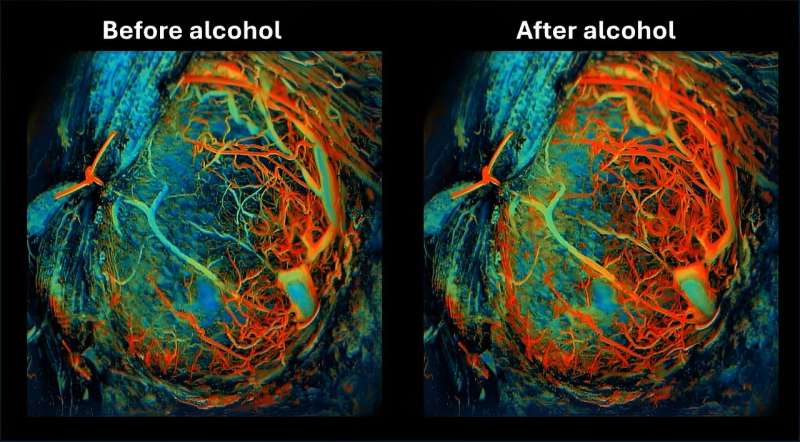This article has been reviewed according to Science X's editorial process and policies. Editors have highlighted the following attributes while ensuring the content's credibility:
fact-checked
peer-reviewed publication
trusted source
proofread
Researchers create real-time view of placental development in mice

Physicians and biomedical engineers at Duke University have developed a method to visualize the growth of a placenta throughout a mouse's pregnancy. By coupling an implantable window with ultrafast imaging tools, the approach provides the first opportunity to track placental development to better understand how the organ functions during pregnancy.
This new perspective gives researchers a precise way to examine how lifestyle factors like alcohol consumption and health complications like inflammation can affect the placenta and potentially lead to adverse pregnancy outcomes.
The research appears as the cover article in Science Advances.
The placenta is a highly vascular organ that forms between the mother and fetus, providing oxygen and nutrients while removing waste. Even though problems in its development can lead to a cadre of health issues for both parties, little is known about how it grows and functions and there are few effective treatments for when things go wrong.
Much of this is because the organ has proved difficult to study. Researchers rely on mouse models because mouse and human placentas share similar anatomical, cellular and molecular features. But even this is tricky, as the organ is deep in the abdominal cavity and is constantly moving, making it a challenge to image with traditional tools.
A new approach developed by Junjie Yao, associate professor of biomedical engineering at Duke, and Dr. Liping Feng, associate professor of obstetrics and gynecology at the Duke University School of Medicine, bypasses these problems by creating a safe, implantable window that provides direct access to the placenta in pregnant mice. By pairing this tool with the imaging technique ultrafast functional photoacoustic microscopy (UFF-PAM), the team can capture highly detailed images of the blood flow and oxygen metabolism of the complex organ.
Traditional photoacoustic microscopy (PAM) uses the properties of light and sound to capture detailed images of organs, tissues and cells throughout the body. The technique uses a laser to send light into a targeted tissue or cell.
When the laser hits the cell, it heats up and expands instantaneously, creating an ultrasonic wave that travels back to a sensor. The UFF-PAM system relies on a combination of hardware advancements and machine learning algorithms to upgrade this technique, making it faster and more sensitive.
The team first used their technique to study placental blood supplies during a healthy pregnancy. From day seven to day 19 of fetal development, the team tracked blood vessel size, vessel density and oxygen levels.
Oxygen levels dropped slightly from day seven to day 10, while both blood vessel diameter and density increased by more than 200%.
"We normally see that low-oxygen environment in tumors, not in organs," said Yao. "But the highly vascular placenta grows quickly, just like the tumors. The low-oxygen environment triggers the placenta to grow a lot of vessels to facilitate the exchange of nutrients, oxygen and waste products between the mother and the fast-developing fetus. As the vessels develop, the oxygen level rises."
"These tools not only help us to understand how pregnancy complications happen but also provide a pre-clinical tool for drug screening," Feng said. They also want to test how common drugs, like aspirin, affect pregnancy.
"There is so much we don't know about pregnancy, especially from a fundamental research perspective," Yao said. "We're hopeful that this tool can help us tackle those long-standing problems and mysteries so we can make pregnancy safer."
More information: Xiaoyi Zhu et al, Longitudinal intravital imaging of mouse placenta, Science Advances (2024). DOI: 10.1126/sciadv.adk1278



















